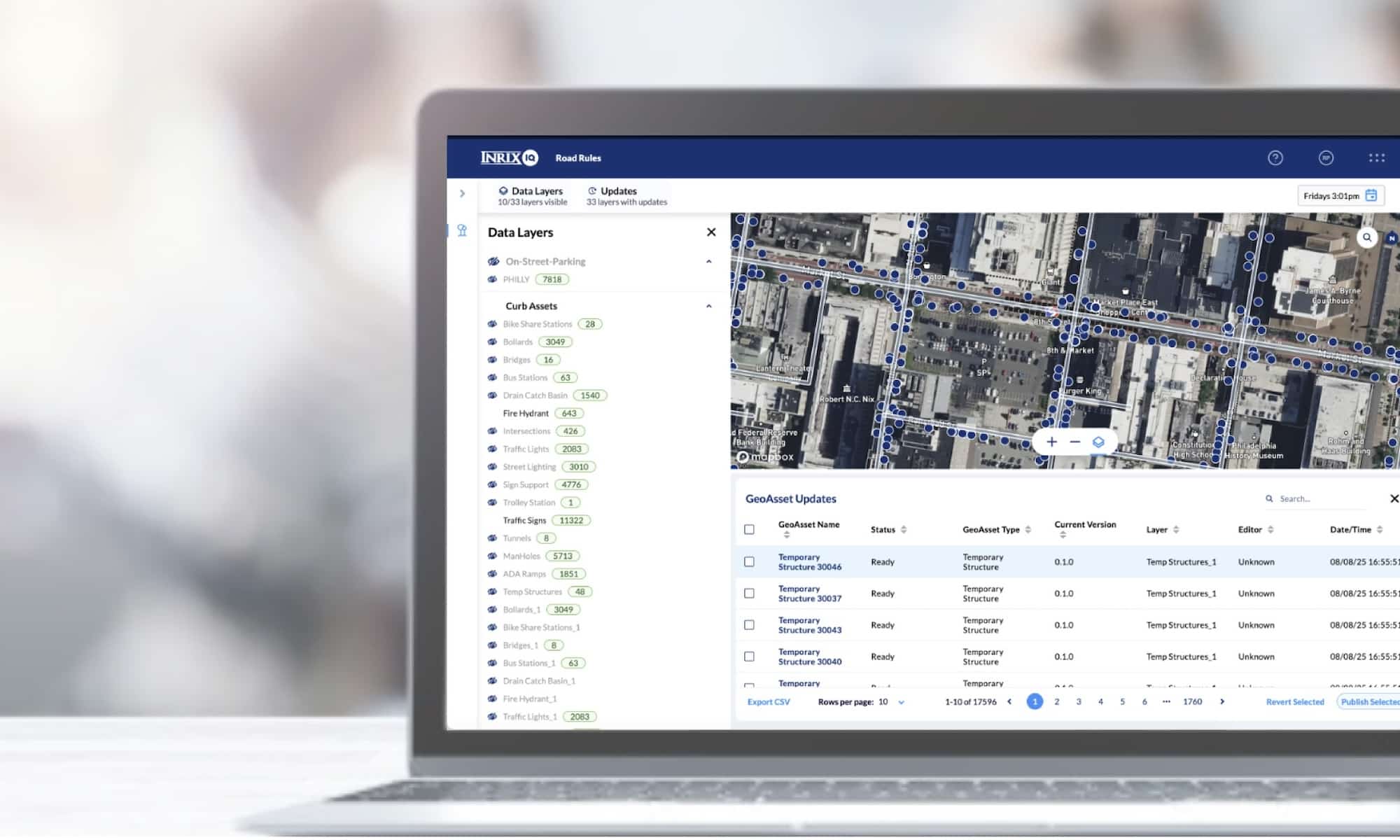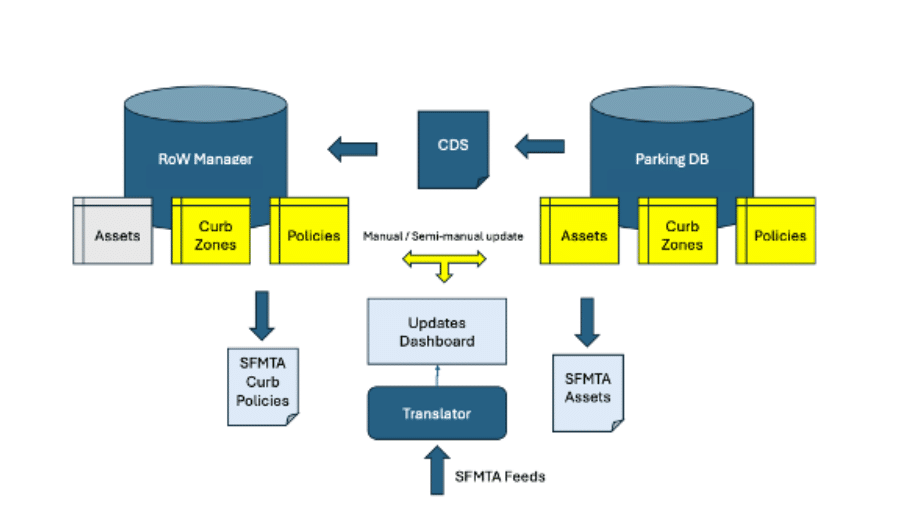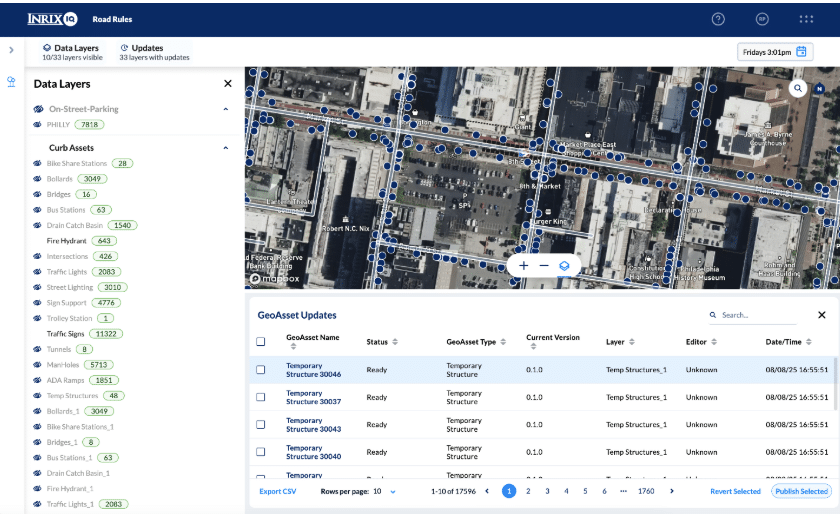
There has been a push from cities in the last decade to assemble digital records of their curbs.
The default approach has been to use signs and other street assets (e.g., curb paint, parking meters, bus shelters, etc.) to derive policies. Under this approach, in order to keep the curb policies up to date, the assets need to be accurate, and the changes need to be updated in a timely fashion. See INRIX’s alternative approach to collection and maintenance in the Belt and Suspenders section below.
The San Francisco Municipal Transportation Agency Digital Curb Project
For the San Francisco Municipal Transportation Agency (SFMTA)’s Digital Curb Project, INRIX was tasked with building a system by which we linked and updated our existing curb data with SFMTA assets and then built an automated process to have asset updates keep the curb rules and policies up to date. For example, as the SFMTA implements the new California State law that requires a no-stopping/no-parking zone within 20 feet of an intersection (daylighting), their “paint shop” will log each block that gets new paint put on those 20 feet and then gets represented in its Enterprise Asset Management System (EAMS) database and API. As a follow-on step, the parking rules for that block need to be updated. INRIX developed an automated process to ensure that changes like this are incorporated into its Road Rules Right of Way (RoW) Manager product thereby updating the curb database with the latest and greatest, along with the APIs consumed by INRIX customers and general San Francisco parking stakeholders. See the Figure below, with “SFMTA Feeds” representing sign, paint, meter, and temporary tow zone updates.

The Belts and Suspender Approach to Maintaining Assets
INRIX has traditionally collected and maintained its curb data at scale by not relying on assets, allowing us to capture nuance for asset-free parking policies such as driveways (see this blog for more details). However, this deep integration with SFMTA’s assets (we are also doing this in the cities of Minneapolis and Philadelphia) provides us with a new “belts and suspenders” way of updating the curb that can be even more timely since the edits happen within hours or days of the updates being legislated and can even have future “start dates” if the implementation is forthcoming.

INRIX has been fortunate to work with six cities who received federal grants through the Strengthening Mobility and Revolutionizing Transportation (SMART) program and are part of the Open Mobility Foundation’s Smart Curb Collaborative. Through these projects, we have tested how far we can push the Curb Data Specification to meet the needs of our public agency partners and the private sector stakeholders who must consume the data.
Implementing Curb Data Specification Objects on a Citywide Scale
For SFMTA’s Digital Curb Project, INRIX implemented the first citywide use of CDS Objects, a specification not even formally released for how to represent “assets located adjacent to, overlapping, within, or associated with a Curb Space or Curb Zone.” This means that other departments and private stakeholders (e.g., autonomous vehicle companies, last mile delivery companies, consultants, etc.) can access the data in the same format, regardless of geography.
This represents a significant step in our approach to building tools that ensures we adapt our APIs to meet developing standards like CDS. This includes the Mobility Data Specification for shared mobility data INRIX represents in tools like Ride Report and also our work with the City of Philadelphia on developing a new standard to represent the full street right of way, including sidewalks and travel lanes. Before the Open Mobility foundation and open source standards existed, INRIX used a proprietary format for representing curb policies. In the last few years, we have updated our systems to store information about geometries and assets (known internally as geoassets) and policies generically before putting them into an output format. This means when we completed the asset integration, we were able to share the information with SFMTA in their own Curb Data Model (maintained as part of their Curb Management Strategy) as well as CDS giving SFMTA time to work with their existing tools and understand how CDS meets their use cases while still being able to represent policies and assets in the emerging standard.

Using Agency Permitting and Contracting Authority to Further CDS Adoption
In the longer run, OMF and its members should work to ensure CDS covers internal and external use cases so that cities (and INRIX) do not need to maintain multiple curb specifications. While INRIX is able to provide multiple formats for customers, it does not help further emerging standards as is the mission of OMF and also causes some of the challenges of bespoke formats (i.e., vendor lock in and lack of interoperability). As these use cases are covered, cities can start to require that use of the standards for all parking and mobility related contracts such as parking payment and enforcement contract. We look forward to working alongside city agencies and the OMF on this transition to widespread adoption of standards like CDS.




